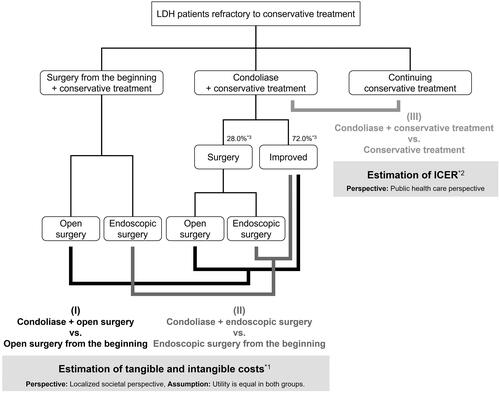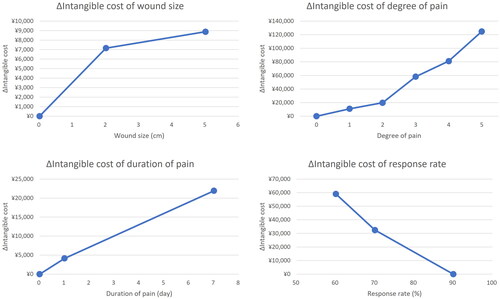Figures & data
Figure 1. Schematic diagram of the study design. *1A cost comparison was performed between surgery for patients with inadequate efficacy at 13 weeks after condliase treatment and surgery from the beginning. If the efficacy is equal in both groups, the cost after the second year of treatment can be considered equivalent. Therefore, the analysis period was set to one year. Since conservative treatment is no longer necessary once patients are completely cured, medical costs for conservative treatment were calculated by setting an upper limit on the number of treatment. *2The time horizon for this analysis was set at 2 years. As a sensitivity analysis, the efficacy at 3 and 4 years after treatment were also calculated. Since QOL data during longer condliase treatment than 1 year were not available, the analysis was performed assuming that the QOL at 1 year in this analysis persisted. It was assumed that conservative treatment in the condliase group remained the same for two years after condliase administration as in the conservative treatment group (conservative conditions unfavorable to condliase). Therefore, medical costs for conservative treatment would be offset in both groups. *3The response rate for condoliase was assumed to be 72.0%, which is the response rate at 13 weeks after treatment with condoliase (95% CI: 62.2–81.7%)Citation9, and the remaining 28.0% were assumed to undergo open surgery at 13 weeks.

Table 1. Attributes and levels of conjoint cards.
Table 2. An example of a conjoint card used in the online survey.
Figure 2. ΔIntangible cost of each attribute. The results of the conjoint analysis in are visualized on the wound size, pain duration, pain level, and the response rate with linear interpolation between each level.

Table 3. Results of the conjoint analysis for group 1.
Table 4. Results of the questionnaire for group 2.
Table 5. Results of the cost analyses.
Table 6. Frequency of adverse events and medical costs of condoliase.
Table 7. Frequency of adverse events and medical costs of surgery.
Table 8. QOL changes after condoliase treatment.
